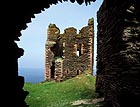Packwood House to Baddesley Clinton, a snatched last walk of this lovely, if strange summer
Fiona Reynolds visits two National Trust properties on a glorious Indian summer’s day.


On a divine September day, I’m heading for south Warwickshire. This little corner of England, deep in the ancient Forest of Arden, has a surprisingly low profile. The setting for Shakespeare’s As You Like It and still scattered with remnants of ancient woodland, it’s protected by Birmingham’s green belt and is a quiet place full of secrets and surprises.
Two of those surprises are glorious National Trust manor houses, survivors from another age, and we’re going to walk between them. They still sit in their historic landscapes, but now nestle among their modern equivalents, for this is a place where today’s prosperous Midlanders also like to live.
I meet my friend, who works for the Trust, at Packwood House. I first came here when I was about 10, with my garden-loving grand-father. A tough Northumbrian farmer, he was blown away by the ‘apostle’ yews grouped in the garden like great, green statues and the glorious deep, colour-rich flower borders; 50 years on, they’re as spectacular as ever.
We’re thrilled to see the head gardener, Mick, back from furlough with his small team (there are no volunteers in these Covid-19 days), working hard to ensure the borders’ usual flawless presentation. The pandemic has been simply horrible for the Trust, but Mick and his team exemplify the love and dedication I always associate with its staff.
Packwood House was donated to the Trust in the 1940s by Graham Baron Ash, a Birmingham industrialist whose father bought the house; he set about restoring it to honour its Tudor origins.
It was built in the late 1550s for the Fetherston family, who lived here until the end of the 19th century. It was the Fetherstons who planted the extraordinary yew garden in the 1650s, supposedly to represent the Sermon on the Mount, with 12 ‘apostles’ and four ‘evangelists’ at its heart. It is, quite simply, remarkable.

We leave Packwood by its beautiful tree-lined avenue (also cared for by the Trust), which runs for more than a mile east-north-east. Dappled light and a soft breeze waft us along and we soon reach Uplands Farm, where we zig-zag to join the road that forms the northern border of the Baddesley Clinton estate, the second Trust house on our route. Incidentally, it was the first house to be covered in Country Life’s architectural pages, in 1897.
Exquisite houses, the beauty of Nature, and how to get the most from your life, straight to your inbox.
We cross the Grand Union Canal at Rising Bridge before we turn south along the drive and pass through the romantic parkland strewn with ancient trees. We feel as if we’re stepping back in time — and we are: the parkland and house date from the 13th century, when the land was cleared from the forest.
We graze the edge of the gardens, catching sight of the moated manor house through the trees. It was long in the hands of the Ferrers family and is an intriguing place, with priest holes and hidden passages reflecting the family’s staunch Catholicism throughout the Reformation.
Leaving Baddesley Clinton, we briefly join the Heart of England Way to return to the Grand Union Canal, this time taking to the towpath. It’s still and magical, with a family of swans lazily feeding. Soon, we’re at Kingswood Junction, where the Grand Union meets its branch, the Stratford-upon-Avon Canal. We’re now in a late-18th-century landscape, where we navigate a beautifully constructed series of locks and pools, the towpaths connected by delicate brick bridges, each works of industrial art.
We wend our way through the junction and past the famous Lapworth Locks, a flight of eight narrow (one-barge wide) locks, busy with people enjoying the sunshine or waiting their turn to pass. Reluctantly, beyond Lapworth, we leave the canal to walk north to Packwood House where we say goodbye. We’re refreshed and full of joy, having snatched a last walk of this lovely, if strange summer. 

The Travellers Club: Home to London's globe trotters for the past 200 years
To mark the bicentenary of The Travellers Club, the oldest club in Pall Mall, John Martin Robinson tells the story

Houses to visit in Central England
Jeremy recommends country houses to visit in central England from his book 'How to Read a Country House'
Fiona Reynolds is chair of the Food, Farming and Countryside Commission, the former director-general of the National Trust, former Master of Emmanuel College, Cambridge, and the author of The Fight for Beauty. Follow her on Twitter @fionacreynolds.
-
 What on earth is the person who comes up with Annabel's otherworldly facade displays on? London's most magical Christmas shop displays
What on earth is the person who comes up with Annabel's otherworldly facade displays on? London's most magical Christmas shop displaysPhotographs by Greg Funnell.
-
 What trees taught me about perfect planting — Alan Titchmarsh
What trees taught me about perfect planting — Alan TitchmarshSense and patience is key to growing healthy trees, as a certain Mr Mackenzie showed a young Alan Titchmarsh
